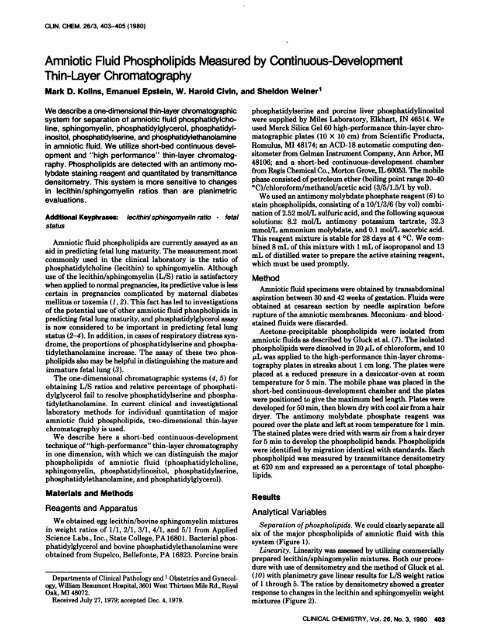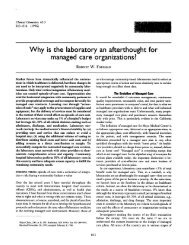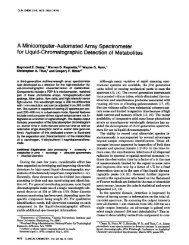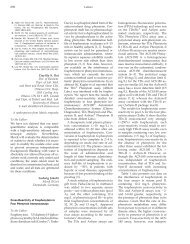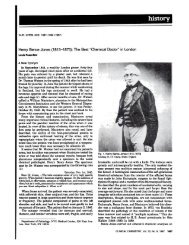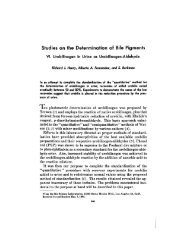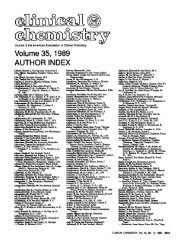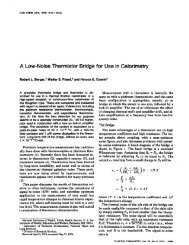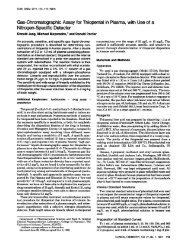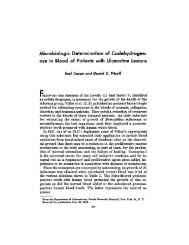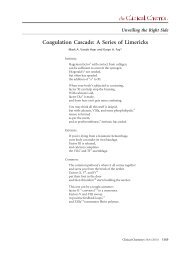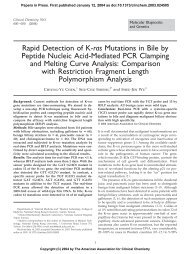Amniotic Fluid Phospholipids Measured by ... - Clinical Chemistry
Amniotic Fluid Phospholipids Measured by ... - Clinical Chemistry
Amniotic Fluid Phospholipids Measured by ... - Clinical Chemistry
Create successful ePaper yourself
Turn your PDF publications into a flip-book with our unique Google optimized e-Paper software.
CLIN.CHEM.26/3, 403-405 (1980)<br />
<strong>Amniotic</strong> <strong>Fluid</strong> <strong>Phospholipids</strong> <strong>Measured</strong> <strong>by</strong> Continuous-Development<br />
Thin-Layer Chromatography<br />
Mark D. Kolins, Emanuel Epstein, W. Harold Civin, and Sheldon Weiner’<br />
We describe a one-dimensional thin-layer chromatographic<br />
system for separation of amniotic fluid phosphatidyicholine,<br />
sphingomyelin, phosphatidylglycerol, phosphatidylinositol,<br />
phosphatidylserine, and phosphatidylethanolamine<br />
in amniotic fluid. We utilize short-bed continuous development<br />
and “high performance” thin-layer chromatography.<br />
<strong>Phospholipids</strong> are detected with an antimony molybdate<br />
staining reagent and quantitated <strong>by</strong> transmittance<br />
densitometry. This system is more sensitive to changes<br />
in lecithin/sphingomyelin ratios than are planimetric<br />
evaluations.<br />
AddItIonalKeyphrases: lecithinlsphingomyelin ratio fetal<br />
status<br />
<strong>Amniotic</strong> fluid phospholipids are currently assayed as an<br />
aid in predicting fetal lung maturity. The measurement most<br />
commonly used in the clinical laboratory is the ratio of<br />
phosphatidylcholine (lecithin) to sphingomyelin. Although<br />
use of the lecithin/sphingomyelin (L/S) ratio is satisfactory<br />
when applied to normal pregnancies, its predictive value is less<br />
certain in pregnancies complicated <strong>by</strong> maternal diabetes<br />
mellitus or toxemia (1, 2). This fact has led to investigations<br />
of the potential use of other amniotic fluid phospholipids in<br />
predicting fetal lung maturity, and phosphatidylglycerol assay<br />
is now considered to be important in predicting fetal lung<br />
status (2-4). In addition, in cases of respiratory distress syndrome,<br />
the proportions of phosphatidylserine and phosphatidylethanolamine<br />
increase. The assay of these two phospholipids<br />
also may be helpful in distinguishing the mature and<br />
immature fetal lung (3).<br />
The one-dimensional chromatographic systems (4, 5) for<br />
obtaining L/S ratios and relative percentage of phosphatidylglycerol<br />
fail to resolve phosphatidylserine and phosphatidylethanolamine.<br />
In current clinical and investigtional<br />
laboratory methods for individual quantitation of major<br />
amniotic fluid phospholipids, two-dimensional thin-layer<br />
chromatography is used.<br />
We describe here a short-bed continuous-development<br />
technique of “high-performance” thin-layer chromatography<br />
in one dimension, with which we can distinguish the major<br />
phospholipids of amniotic fluid (phosphatidylcholine,<br />
sphingomyelin, phosphatidylinositol, phosphatidylserine,<br />
phosphatidylethanolamine, and phosphatidyiglycerol).<br />
Materials<br />
and Methods<br />
Reagents and Apparatus<br />
We obtained egg lecithin/bovine sphingomyelin mixtures<br />
in weight ratios of 1/1, 2/1, 3/1, 4/1, and 5/1 from Applied<br />
Science Labs., Inc., State College, PA 16801. Bacterial phosphatidylglycerol<br />
and bovine phosphatidylethanolamine were<br />
obtained from Supelco, Bellefonte, PA 16823. Porcine brain<br />
Departments of <strong>Clinical</strong> Pathology and 1 Obstetrics and Gynecology,<br />
William Beaumont Hospital, 3601 West Thirteen Mile Rd., Royal<br />
Oak, MI 48072.<br />
Received July 27, 1979; accepted Dec. 4, 1979.<br />
phosphatidylserine and porcine liver phosphatidylinositol<br />
were supplied <strong>by</strong> Miles Laboratory, Elkhart, IN 46514. We<br />
used Merck Silica Gel 60 high-performance thin-layer chromatographic<br />
plates (10 X 10 cm) from Scientific Products,<br />
Romulus, MI 48174; an ACD-18 automatic computing densitometer<br />
from Gelman Instrument Company, Ann Arbor, MI<br />
48106; and a short-bed continuous-development chamber<br />
from Regis Chemical Co., Morton Grove, IL 60053. The mobile<br />
phase consisted of petroleum ether (boiling point range 20-40<br />
oC)/chloroform/methanol/acetic acid (3/5/1.5/1 <strong>by</strong> vol).<br />
We used an antimony molybdate phosphate reagent (6) to<br />
stain phospholipids, consisting of a 10/1/3/6 (<strong>by</strong> vol) combination<br />
of 2.52 mol/L sulfuric acid, and the following aqueous<br />
solutions: 8.2 mol/L antimony potassium tartrate, 32.3<br />
mmol/L ammonium molybdate, and 0.1 molfL ascorbic acid.<br />
This reagent mixture is stable for 28 days at 4 #{176}C. We combined<br />
8 mL of this mixture with 1 mL of isopropanol and 13<br />
mL of distilled water to prepare the active staining reagent,<br />
which must be used promptly.<br />
Method<br />
<strong>Amniotic</strong> fluid specimens were obtained <strong>by</strong> transabdominal<br />
aspiration between 30 and 42 weeks of gestation. <strong>Fluid</strong>s were<br />
obtained at cesarean section <strong>by</strong> needle aspiration before<br />
rupture of the amniotic membranes. Meconium- and bloodstained<br />
fluids were discarded.<br />
Acetone-precipitable phospholipids were isolated from<br />
amniotic fluids as described <strong>by</strong> Gluck et al. (7). The isolated<br />
phospholipids were dissolved in 20 tL of chloroform, and 10<br />
was applied to the high-performance thin-layer chromatography<br />
plates in streaks about 1 cm long. The plates were<br />
placed at a reduced pressure in a desiccator-oven at room<br />
temperature for 5 mm. The mobile phase was placed in the<br />
short-bed continuous-development chamber and the plates<br />
were positioned to give the maximum bed length. Plates were<br />
developed for 50 mm, then blown dry with cool air from a hair<br />
dryer. The antimony molybdate phosphate reagent was<br />
poured over the plate and left at room temperature for 1 mm.<br />
The stained plates were dried with warm air from a hair dryer<br />
for 5 mm to develop the phospholipid bands. <strong>Phospholipids</strong><br />
were identified <strong>by</strong> migration identical with standards. Each<br />
phospholipid was measured <strong>by</strong> transmittance densitometry<br />
at 620 nm and expressed as a percentage of total phospholipids.<br />
Results<br />
AnalyticalVariables<br />
Separation of phospholipids. We could clearly separate all<br />
six of the major phospholipids of amniotic fluid with this<br />
system (Figure 1).<br />
Linearity. Linearity was assessed <strong>by</strong> utilizing commercially<br />
prepared lecithin/sphingomyelin mixtures. Both our procedure<br />
with use of densitometry and the method of Gluck et al.<br />
(10) with planimetry gave linear results for L/S weight ratios<br />
of 1 through 5. The ratios <strong>by</strong> densitometry showed a greater<br />
response to changes in the lecithin and sphingomyelin weight<br />
mixtures (Figure 2).<br />
CLINICALCHEMISTRY,Vol.26, No. 3, 1980 403
15<br />
8<br />
7<br />
0<br />
a<br />
o5<br />
-J<br />
6<br />
4<br />
3<br />
2<br />
Fig. 1. Separation of the amniotic fluid phospholipids from amniotic<br />
fluid obtained at cesarean section<br />
S, sphingomyelin; L, lecithin; P1,phosphatidylinositol; PS,phosphatidylserine;<br />
PE. phosphatidylethanolamIne; P0, phosphatidylglycerol; X, unidentifIed<br />
Color stability. The phospholipids appear as blue bands<br />
within 5 mm. The color is stable for at least 30 mm.<br />
Accuracy and precision. Commercial mixtures of phosphatidylcholine<br />
and sphingomyelmn at weight ratios of 1/1,2/1,<br />
3/1,4/1, and 5/1 were assayed <strong>by</strong> the described method. Corresponding<br />
L/S ratios in duplicate determinations were 1.30<br />
and 1.38, 1.97 and 1.93, 2.27 and 2.33, 3.08 and 3.06, and 3.98<br />
and 3.82.<br />
We assessed within-day precision for the high L/S ratio<br />
range <strong>by</strong> running 10 aliquots of pooled amniotic fluid obtained<br />
at cesarean section. The mean L/S ratio was 9.13 (SD 0.88),<br />
with a CV of 9.68%. The mean percentage of phosphatidylglycerol<br />
(of total phospholipid) was 3.23 (SD 0.59), with a CV<br />
of 18.4%. The mean percentage of phosphatidylmnositol was<br />
26.3 (SD 2.7), with a CV of 10.2%.<br />
Within-day precision for the low L/S ratio range was assessed<br />
<strong>by</strong> isolating 10 aliquots of an equi-weight mixture of<br />
phosphatidylcholine and sphingomyelin. The mean L/S ratio<br />
ss<br />
Fig.2.Densitometrictraceofamnioticfluidphospholipids<br />
Abbreviations as in Fig. 1<br />
P1<br />
-‘-<br />
L<br />
1<br />
Borer’s<br />
Method<br />
HP-TLC<br />
Fig.3.Distribution ofLIS ratios inpairedspecimens run<strong>by</strong>the<br />
presentmethod (HP-TLC)and thatofGlucketal.(10) (Borer’s<br />
method)<br />
was 0.85 (SD 0.08), with a CV of 9.56%. Day-to-day precision<br />
was assessed <strong>by</strong> isolating phospholipids on four consecutive<br />
days. Nine aliquots of the 1/1 mixture of lecithin and sphingomyelin<br />
were run each day. The mean L/S ratio was 0.96 (SD<br />
0.20, CV 21.3%).<br />
<strong>Clinical</strong><br />
Studies<br />
We quantitated phospholipids in 22 specimens. Phosphatidylglycerol<br />
was identified in all these, with L/S ratios ranging<br />
from 2.9 to 15.3. None of these infants subsequently developed<br />
the respiratory distress syndrome.<br />
L/S ratios were assessed <strong>by</strong> our procedure and <strong>by</strong> the<br />
method of Gluck et al. (10) in 30 paired specimens. There was<br />
clustering of ratios <strong>by</strong> the latter method, in contrast to the<br />
broader distribution <strong>by</strong> ours, which suggests that the present<br />
method discriminates better (Figure 3). Two specimens obtained<br />
at cesarean section gave low L/S ratios (1.8 and 1.9) <strong>by</strong><br />
the method of Gluck et al. (10); our method gave higher values<br />
(3.0 and 2.7, respectively). <strong>Fluid</strong> from the former case also<br />
contained phosphatidyiglycerol. Neither case developed the<br />
respiratory distress syndrome.<br />
Discussion<br />
In this high-performance thin-layer chromatographic system,<br />
silica gel is used as in conventional thin-layer chromatography,<br />
but the particle size of the adsorbent material is<br />
more uniform, about 7 sum. This allows for a densely packed<br />
thin layer, which results in better resolution between similar<br />
phospholipids (Figure 1). In conventional thin-layer chromatography,<br />
in general, the particle distribution is in the range<br />
of 5 to 30 zm; this less-dense adsorbent layer results in larger<br />
and more diffuse spots.<br />
The short-bed continuous-development chamber can better<br />
404 CLINICAL CHEMISTRY, Vol. 26, No. 3, 1980
0<br />
a<br />
CO<br />
-J<br />
4<br />
3<br />
2<br />
0.5<br />
A<br />
Slope 0.20<br />
1 2 3 4 5<br />
Commercial Lecithin (mg)mixed with 1mg Sphingomyelin<br />
Fig. 4. Sensitivity of the present method (HP-TLC) and that of<br />
Gluck et al. (10) (Borer’s method) compared <strong>by</strong> use of commercially<br />
prepared L/S mixtures<br />
The slope for the present method is nearly three times greater, indicating its<br />
greater sensitivity to changes in iecithin/sphingomyelin concentration<br />
resolve substances with similar Rf’s. The Rf’s of substances<br />
generally vary with solvent (mobile phase) strengths (8), but<br />
if solvent concentrations are changed too much, the solvent<br />
may traverse the chromatography plate before the substances<br />
have moved from the origin. The short-bed continuous-development<br />
chamber overcomes this difficulty because the<br />
thin-layer chromatographic plate protrudes out of the otherwise<br />
sealed chamber, permitting the solvent to move up the<br />
plate and evaporate outside the chamber. Therefore, solvent<br />
is continuously moving up the plate at a constant velocity. In<br />
addition, as the distance to be traversed <strong>by</strong> the solvent is decreased,<br />
solvent velocity increases (9). This continuous<br />
movement of solvent results in resolution equivalent to that<br />
with a much longer chromatographic plate or column, and the<br />
high solvent velocity shortens the time required.<br />
We found phosphatidylinositol and phosphatidylcholine<br />
to have similar R1’s in solvent systems utilized <strong>by</strong> other investigators<br />
(4). This was also true of phosphatidylsermne and<br />
phosphatidylethanolamine. Thus, to achieve separation, we<br />
used the short-bed continuous-development system and<br />
added petroleum ether to reduce the polarity of the solvent.<br />
The greater sensitivity of the present method as compared<br />
with commonly used planimetric evaluation of L/S ratios (10)<br />
is emphasized <strong>by</strong> comparison of the slopes obtained (Figure<br />
4). The slope for the present method is nearly three times that<br />
for the method of Gluck et al. (10), indicating that our system<br />
gives a greater change in the calculated L/S ratio for a change<br />
in the L/S weight mixtures. Although we did not obtain<br />
identical values for commercial L/S mixtures and L/S ratios<br />
determined <strong>by</strong> our procedure, there is a constant proportion<br />
between the two (Figure 4), as there also is for the method of<br />
Glucketal. (10).<br />
The popularity of the method of Gluck et al. lies in avoiding<br />
the need for sulfuric acid charring; our method also has this<br />
advantage. In addition, densitometric quantification of<br />
phospholipids enables a more rapid assessment of all phospholipid<br />
bands than planimetry.<br />
With our system, one-dimensional separation of the major<br />
phospholipids currently being evaluated in predicting fetal<br />
lung status is possible. Studies <strong>by</strong> Hallman et al. (3) have<br />
suggested that phosphatidylethanolamine and phosphatidylserine<br />
make up a significantly higher percentage of total<br />
phospholipids in infants who develop the respiratory distress<br />
syndrome. Isolation and quantification of these phospholipids<br />
from amniotic fluids may prove to be an indicator of immature<br />
fetal lung status, in contrast to phosphatidylglycerol, which,<br />
when present, indicates mature fetal lung status (11, 12). The<br />
converse, however, is not true: the absence of phosphatidylglycerol<br />
does not necessarily indicate an immature lung.<br />
Therefore, phosphatidylethanolamine and phosphatidylserine<br />
may yield useful information in complicated pregnancies,<br />
when the L/S ratio is frequently high despite immature lung<br />
status (3).<br />
References<br />
I. Gluck, L., and Kulovich, M. V., Lecithin/sphingomyelin ratios in<br />
amniotic fluid in normal and abnormal pregnancy. Am J. Obstet.<br />
Gynecol. 115, 539-546 (1973).<br />
2. Cunningham, M. D., Desai, N. S., Thompson, S. A., and Greene,<br />
J. M., <strong>Amniotic</strong> fluid phosphatidylglycerol in diabetic pregnancies.<br />
Am. J. Obstet. Gynecol. 131, 719-724 (1978).<br />
3. Hallman, M., Feldman, B. H., Kirkpatrick, E., and Gluck, L.,<br />
Absence of phosphatidylglycerol (PG) in respiratory distress syndrome<br />
in the newborn. Pediat. Res. 11, 714-720 (1977).<br />
4. Tsai, M. Y., and Marshall, J. G., Phosphatidylglycerol in 261<br />
samples of amniotic fluid from normal and diabetic pregnancies, as<br />
measured <strong>by</strong> one-dimensional thin-layer chromatography. Clin.<br />
Chem. 25, 682-685 (1979).<br />
5. Gotelli, G. R., Stanfill, R. E., Kabra, P. M., et al., Simultaneous<br />
determination of phosphatidylglycerol and the lecithin/sphingomyelin<br />
ratio in amniotic fluids. Clin. Chem. 24, 1144-1146 (1978).<br />
6. Manual of Methods for Chemical Analysis of Water and Wastes<br />
(EPA-625/6-74-003), U. S. Environmental Protection Agency,<br />
Washington, D. C., 1974, pp 249-255.<br />
7. Gluck, L., Kulovich, M. V., Borer, R. C., et al., Diagnosis of the<br />
respiratory distress syndrome <strong>by</strong> amniocentesis. Am. J. Obstet. Gynecol.<br />
109, 440-445 (1971).<br />
8. Perry, J. A., A new look at solvent strength selectivity and continuous<br />
development. J. Chromatogr. 165, 117-140 (1979).<br />
9. Shortbed/Continuous Development Technical Manual, Regis<br />
Chemical Co., Morton Grove, IL.<br />
10. Gluck, L., Kulovich, M. V., and Borer, R. C., Estimates of fetal<br />
lung maturity. Clin. Perinatol. 1, 125 (1974).<br />
11. Kulovich, M. V., Hallman, M. B., and Gluck, L., The lung profile.<br />
I. Normal pregnancy. Am. J. Obstet. Gynecol. 135, 57-63 (1979).<br />
12. Kulovich, M. V., and Gluck, L., The lung profile. II. Complicated<br />
pregnancy. Am. J. Obstet. Gynecol. 135, 64-70 (1979).<br />
CLINICAL CHEMISTRY, Vol. 26, No. 3, 1980 405


